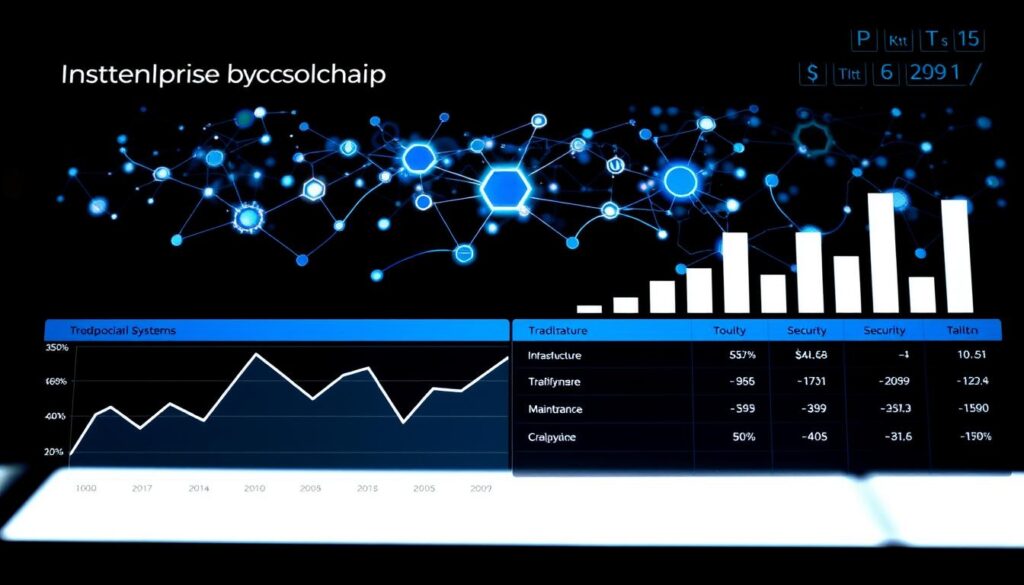Now Reading: Unlock the Secrets of Digital Currency Trading
- 01
Unlock the Secrets of Digital Currency Trading
Unlock the Secrets of Digital Currency Trading
The world of cryptocurrency trading is changing fast. It’s opening up new chances for investors and traders. As the digital financial landscape grows, knowing how to trade digital currencies is more important than ever.

With more people interested in cryptocurrencies, trading them is becoming a way to add variety to investments. But, the world of cryptocurrency trading is complex. It needs knowledge and a good plan.
Key Takeaways
- Cryptocurrency trading offers new investment opportunities.
- Understanding digital currency is crucial for success.
- A well-informed strategy is key to navigating the market.
- Cryptocurrency trading can diversify investment portfolios.
- Knowledge of the market is essential for making informed decisions.
What is Digital Currency Trading?
Digital currency trading is a growing field where people can buy and sell cryptocurrencies online. They use online trading platforms and crypto exchanges to do this.
Defining Cryptocurrencies and Blockchain Technology
Cryptocurrencies are digital or virtual money that use cryptography for security. They are not controlled by any government or financial institution. Blockchain technology is what makes cryptocurrencies possible.
Key Components of Blockchain Networks
- Decentralized network of nodes
- Cryptographic algorithms for security
- Distributed ledger technology
Types of Consensus Mechanisms
Consensus mechanisms are key for validating transactions on blockchain networks. The main types are:
- Proof of Work (PoW)
- Proof of Stake (PoS)
- Delegated Proof of Stake (DPoS)
How Digital Currency Trading Differs from Traditional Markets
Digital currency trading is different from traditional financial markets in many ways.
24/7 Market Availability
Digital currency markets are open 24/7. This means there’s always time for digital asset trading.
Decentralization Benefits
The decentralized nature of cryptocurrencies offers autonomy and transparency. This is not common in traditional financial systems.
The Evolution of Digital Currency Markets
The digital currency market has changed a lot since it started. At first, Bitcoin was the only one. But now, there are thousands of other cryptocurrencies, or altcoins.
From Bitcoin to Thousands of Altcoins
Altcoins have made the market more diverse. This change came from a need for new ideas and specialized coins.
Major Milestones in Cryptocurrency History
- Bitcoin started the digital currency era in 2009.
- Ethereum came out in 2015, adding smart contracts to the mix.
- Big moments include forks, new rules, and the rise of DeFi.
Market Capitalization and Trading Volume Growth
The market’s value and trading have grown a lot. This shows more people are interested in digital currencies.
Institutional Adoption Trends
- Big investors have helped the market grow. They want to get into digital assets.
- New financial products have made it easier for them to join.
- As rules change, more big players are likely to join, pushing the market forward.
The digital currency market keeps changing. It’s influenced by new tech, rules, and what investors want. Knowing these trends is key for those trading cryptocurrencies and blockchain.
Getting Started with Digital Currency Trading
To start trading digital currencies, first set up a digital wallet. Then, pick the right exchange for you. This step is key to keeping your digital assets safe and making trades easy.
Setting Up Your Digital Wallet
A digital wallet is vital for managing digital currencies. You can choose between hot storage and cold storage when setting it up.
Hot vs. Cold Storage Options
- Hot Storage: Hot wallets are always online, making trading easy but riskier for hackers.
- Cold Storage: Cold wallets stay offline, offering better security but less convenience for active traders.
Security Best Practices
To keep your wallet safe, use strong passwords and two-factor authentication. Also, update your software regularly. For more tips, check out a beginner’s guide to crypto investing.
Choosing the Right Cryptocurrency Exchange
Choosing the right exchange is crucial for a good trading experience. There are two main types: centralized and decentralized.
Centralized vs. Decentralized Exchanges
- Centralized Exchanges: These traditional exchanges are easy to use but require trust in their security.
- Decentralized Exchanges: Using blockchain, these exchanges offer peer-to-peer transactions, boosting security and privacy.

Verifying Your Identity (KYC Requirements)
Most exchanges need you to verify your identity through KYC. This means sharing personal documents to meet rules and stop fraud.
Knowing these basics helps you start trading digital currencies confidently. You’ll have a secure wallet and know how to pick the best exchange.
Understanding Different Types of Digital Currencies
Since Bitcoin started, digital currencies have grown a lot. Now, we have altcoins, stablecoins, and DeFi tokens. Each type has its own purpose and value.
Bitcoin and Major Altcoins
Bitcoin is well-known, but many altcoins have become popular too. Altcoins like Ethereum, Litecoin, and Bitcoin Cash have their own special features and uses.
Use Cases and Value Propositions
Every major altcoin has its own use. For example, Ethereum is key for dApps and DeFi projects. Knowing these uses helps us see their value in cryptocurrency trading.
Stablecoins and Their Role in Trading
Stablecoins keep their value close to a fiat currency, like the US dollar. They help traders by reducing the risk of market ups and downs.
Fiat-Backed vs. Algorithmic Stablecoins
Fiat-backed stablecoins use real money to back their value. Algorithmic stablecoins use smart math to keep their value steady. Knowing the difference is key for traders.
DeFi Tokens and Yield Farming Opportunities
DeFi tokens are all about decentralized finance. They offer chances for yield farming, voting, and using services in DeFi.
Governance Tokens and Utility Tokens
Governance tokens let people vote on DeFi protocol decisions. Utility tokens give access to certain services. Both are important in DeFi.
In summary, the world of digital currencies is full of chances for traders and investors. It’s important to understand the different types and their roles in this complex market.
Essential Tools for Digital Currency Trading
The world of digital currency trading is complex. Having the right tools is key for making smart decisions. Traders use many tools, like online trading platforms, market analysis tools, and apps to track their portfolios.
Online Trading Platforms and Their Features
Online trading platforms are the main entry point to digital currency markets. They have features like real-time price charts, order execution, and account management. When picking a platform, traders should look at security, user interface, and customer support.
Mobile vs. Desktop Trading Interfaces
Trading interfaces differ between mobile and desktop platforms. Mobile interfaces are convenient and accessible, letting traders check and change their positions anywhere. Desktop interfaces offer a deeper trading experience with advanced charting tools and detailed market data.
Market Analysis Tools
Market analysis tools are key for grasping market trends and making smart trading choices. These tools include:
- Technical analysis software
- Real-time price alerts
- Market sentiment analysis
On-Chain Analytics Platforms
On-chain analytics platforms give insights into blockchain transactions. They help traders understand market dynamics. These platforms offer data on transaction volumes, wallet activity, and other on-chain metrics that guide trading strategies.
Portfolio Tracking Applications
Portfolio tracking applications help traders keep an eye on their investments and make necessary changes. These apps often have features like:
- Real-time portfolio valuation
- Performance analytics
- Tax reporting integrations
Tax Reporting Integrations
Tax reporting integrations are vital for following tax rules. They help traders figure out their gains and losses, making tax filing easier.
In conclusion, the right tools are crucial for traders to succeed in digital currency markets. By using online trading platforms, market analysis tools, and portfolio tracking apps, traders can make better decisions and boost their trading results.
Fundamental Analysis in Digital Currency Trading
In digital currency trading, fundamental analysis is key. It helps traders understand what makes a digital asset valuable. This way, they can make smart choices.
Evaluating Project Fundamentals
Looking at a digital currency project’s basics is crucial. The whitepaper is a must-read. It explains the project’s goals, tech, and future plans.
Whitepaper Assessment Techniques
When reviewing a whitepaper, check a few things:
- Technical architecture
- Use cases
- Competitive landscape
- Tokenomics
A good whitepaper gives a clear view of the project’s strengths and weaknesses.
Team Assessment and Development Activity
The team behind a project is very important. Their experience and past work can tell a lot about the project’s future.
GitHub Metrics and Code Audits
How active a project is matters a lot. GitHub metrics and code audits show if a project is growing and healthy.

Community Engagement and Adoption Metrics
A strong community is key for a project’s success. Looking at social media and forum activity shows how well a project is doing.
Social Sentiment Analysis
Understanding what people think about a project is important. This means watching social media and news to see how people feel.
By using these methods, traders can really understand a project. This helps them make better choices in the cryptocurrency trading world.
Technical Analysis for Cryptocurrency Markets
In the world of cryptocurrency trading, technical analysis shines as a guide. It looks at past market data, like price and volume, to guess future prices. This is especially helpful in the cryptocurrency market because of its quick changes and many price influencers.
Key Chart Patterns for Digital Assets
Chart patterns are key in technical analysis. They show possible future price moves based on past data. Patterns like head and shoulders, triangles, and wedges can signal when trends might change.
Identifying Trend Reversals
Trend reversals are big moments in trading. They show when the market’s direction is about to change. Signs like the inverse head and shoulders or the bullish engulfing pattern can hint at a shift from down to up. Spotting these early can lead to big profits.
Important Technical Indicators
Technical indicators use math to analyze price and volume. They help traders see market trends and future moves. Important ones include moving averages, Relative Strength Index (RSI), and Bollinger Bands.
Volume-Based Indicators
Volume-based indicators, like On-Balance Volume (OBV) and Chaikin Money Flow (CMF), track buying and selling pressure. An up OBV means more buying, while a down OBV means more selling.
Momentum Oscillators
Momentum oscillators, such as RSI and Stochastic Oscillator, spot when prices are too high or too low. They help traders know when to act, like when to buy or sell.
Support and Resistance Levels in Volatile Markets
Support and resistance levels are vital in technical analysis. They show where the market often stops and turns. Knowing these levels helps traders plan when to enter or leave the market.
Using Fibonacci Retracement Tools
Fibonacci retracement tools help find support and resistance levels. By using Fibonacci levels on a chart, traders can guess where prices might stop or consolidate. These levels are based on the Fibonacci sequence and are popular among traders.
By using these technical analysis tools, traders can better understand the cryptocurrency market. This helps them make trades that could lead to profits.
Mastering Digital Currency Trading Strategies
Effective digital currency trading requires understanding and using different strategies. The cryptocurrency market is very volatile. It’s important for traders to be flexible and well-informed. We will look at various trading approaches to help you improve your skills and make better decisions.
Day Trading vs. Swing Trading Cryptocurrencies
Day trading and swing trading are two common strategies in digital currency trading. Day trading means making many trades in one day, using the market’s volatility. It needs constant watching and quick choices. On the other hand, swing trading holds positions for a few days to weeks, longer than day trading but shorter than investing.
Timeframe Selection for Different Strategies
Choosing between day trading and swing trading depends on your timeframe and risk tolerance. Day trading is best for those who can watch the markets closely and make fast decisions. Swing trading, however, is more relaxed, as positions are held for longer.
Position Trading and HODLing
Position trading means holding positions for a long time, based on fundamental analysis. It’s less about short-term changes and more about long-term trends. HODLing, from “holding,” is about keeping your cryptocurrencies, no matter the market, focusing on long-term growth.
Long-Term Investment Thesis Development
Creating a long-term investment thesis is key for position trading and HODLing. It involves studying the basics of the cryptocurrencies you’re interested in. This includes their technology, use cases, and potential for adoption.
Dollar-Cost Averaging Strategy
The dollar-cost averaging strategy means investing a fixed amount regularly, no matter the market. It helps lessen the effects of volatility and timing risks.
Automating Regular Purchases
One great thing about dollar-cost averaging is that it can be automated. This lets you invest regularly without constantly watching the market. Many exchanges and platforms offer features for automating these purchases.
By understanding and using these strategies, traders can better handle the complex world of digital currency trading. Whether you’re a day trader, swing trader, position trader, or HODLer, having a solid strategy is crucial for success in the cryptocurrency market.
Risk Management in Digital Currency Trading
To succeed in digital currency trading, traders need to manage risks well. Risk management is key to protect investments and increase returns in the unpredictable cryptocurrency market.
Setting Stop-Loss and Take-Profit Orders
Setting stop-loss and take-profit orders is a basic risk management strategy. These orders help limit losses and secure profits. A stop-loss order sells a digital asset when it hits a certain price. A take-profit order sells it when it reaches a set high price.
Trailing Stop Strategies
A trailing stop is a variation of the stop-loss order. It moves with the asset’s price changes. This lets traders lock in profits while still allowing the asset to grow. For example, a trailing stop 10% below the current price means selling if the price drops by 10%. But if the price rises, the stop moves up too.
Portfolio Diversification Techniques
Portfolio diversification is another important strategy. Spreading investments across different digital assets reduces risk. This includes investing in various cryptocurrencies, like Bitcoin, altcoins, and stablecoins.
Correlation Analysis Between Assets
When diversifying, it’s crucial to analyze how different assets correlate. This means studying how they move together. Assets with low correlation can lower overall portfolio risk, as they’re less likely to move in sync.
Managing Emotional Responses to Market Volatility
It’s also vital to manage emotions in digital currency trading. The market’s high volatility can lead to impulsive decisions. Traders should aim to stay calm and follow their trading plans.
Developing a Trading Journal
Keeping a trading journal is a good way to manage emotions and improve trading. A journal records each trade, including the reason, outcome, and lessons learned. This helps traders spot patterns and make better decisions.

By using these risk management strategies, traders can better handle the challenges of digital currency trading. This improves their chances of success.
Advanced Digital Currency Trading Techniques
Advanced digital currency trading techniques are changing how traders work in the crypto market. As the market grows, traders look for new ways to lead the pack.
Margin Trading and Leverage
Margin trading lets traders borrow money to grow their trades, which can lead to bigger wins. But, it also means they could lose a lot.
Calculating Liquidation Prices
Knowing how to figure out liquidation prices is key for managing risk in margin trading. Liquidation happens when a trader’s balance drops below the needed margin.
- Determine the initial margin and leverage used
- Calculate the price at which the position will be liquidated
- Adjust the trading strategy accordingly to minimize risk
Futures and Options Trading
Futures and options trading let traders protect against losses or bet on price changes. These tools help with more advanced trading plans.
Hedging Strategies Using Derivatives
Hedging means using a derivative to guard against losses in the real asset. It helps shield against market ups and downs.
- Identify the asset to be hedged
- Choose the appropriate derivative (futures or options)
- Execute the hedge based on market analysis
Arbitrage Opportunities Across Exchanges
Arbitrage is about making money by using price differences between exchanges. It needs fast action and a grasp of market trends.
Triangular Arbitrage Methods
Triangular arbitrage is about changing one currency to another, then to a third, and back to the first. It profits from rate differences.
By learning these advanced trading methods, traders can improve their strategies and maybe earn more. But, it’s vital to know the risks and complexities well.
Blockchain Trading and Forex Integration
The mix of blockchain and Forex is changing digital asset trading. It’s making trading digital currencies and traditional Forex markets more exciting.
Trading Digital Assets on Blockchain Platforms
Blockchain platforms let traders buy and sell digital assets without a middleman. This is thanks to:
- Decentralized Exchange Protocols: These allow direct trades between people.
- Blockchain’s secure and clear nature.
Decentralized Exchange Protocols
Decentralized exchanges (DEXs) let you trade digital assets without a central body. They offer more security and less risk from others.
Forex Trading with Digital Currencies
Adding digital currencies to Forex trading opens up new chances for traders. This includes:
- Trading digital currency pairs, like BTC/USD or ETH/EUR.
- Using stablecoins to lessen market ups and downs.
Currency Pairs and Stablecoin Markets
Stablecoins are key in Forex trading for their stable value. They’re used in pairs to protect against market swings.
Cross-Border Payment Opportunities
Blockchain tech also boosts cross-border payments. This includes:
- Quick and cheap money transfers.
- More financial access for those who need it.
Remittance Use Cases
Remittances are a big win for blockchain, making cross-border payments fast and cheap. This helps people who rely on these payments for income.
Tax Implications of Digital Currency Trading
Digital currency trading is getting more popular in the US. It’s key for traders to know about its tax rules. The tax rules for digital currencies can be tricky, and traders need to follow them to avoid fines.
Understanding Cryptocurrency Tax Regulations in the US
The IRS sees digital currency as property for tax purposes. This means capital gains tax applies to profits from trading cryptocurrencies. This rule is important for how traders report their income.
Capital Gains vs. Income Classification
Knowing the difference between capital gains and income is vital. It affects the tax rate on trading profits. Traders need to figure out if they are investing or trading to understand their tax duties.
Record-Keeping for Tax Compliance
Keeping accurate records is key for tax compliance in digital currency trading. Traders must keep detailed records of their transactions. This includes dates, amounts, and the value of the cryptocurrencies at the time of the transaction.
Transaction History Documentation
Traders should document their transaction history thoroughly. This includes buy and sell orders, exchange transfers, and other relevant activities. This helps in accurately calculating gains and losses.
Working with Crypto-Savvy Tax Professionals
Given the complexity of cryptocurrency tax rules, it’s wise for traders to work with tax experts. These professionals can offer advice on tax planning and ensure compliance.
Audit Preparation Strategies
Being ready for an audit is crucial. Having detailed documentation and understanding tax rules can help a lot. Traders should be ready to show they follow tax laws and regulations.
Navigating the Future of Digital Assets
The world of digital assets is changing fast. Digital currency trading and blockchain trading are leading this change. As the market grows, new chances and challenges will appear.
Blockchain technology might soon be used by banks and other financial groups. This could make digital currency markets more stable and liquid. Also, DeFi is growing, offering new ways to earn money and invest.
It’s crucial for traders and investors to keep up with digital currency and blockchain news. This way, they can move forward with confidence and grab new opportunities.
FAQ
What is digital currency trading, and how does it work?
Digital currency trading is about buying and selling digital money online. It’s like traditional trading but with digital assets instead.
How do I get started with digital currency trading?
First, set up a digital wallet. Then, pick a good exchange and verify your identity. After that, you can start trading with your funds.
What are the different types of digital currencies available for trading?
There are thousands of digital currencies out there. You’ll find Bitcoin, major altcoins, stablecoins, and DeFi tokens. Each has its own special features and uses.
What is the difference between a centralized and decentralized exchange?
Centralized exchanges are run by one person or company. Decentralized exchanges use blockchain and let people trade directly with each other.
How do I manage risk when trading digital currencies?
To manage risk, use stop-loss and take-profit orders. Also, spread out your investments and control your emotions during market ups and downs.
What is margin trading, and how does it work?
Margin trading lets you borrow money to trade with more money. This can increase your gains and losses. It’s important to know how to handle it safely.
How are digital currencies taxed in the US?
In the US, digital currencies are taxed as capital gains or income. Keeping good records and talking to a tax expert who knows crypto is key.
What is blockchain trading, and how does it integrate with Forex markets?
Blockchain trading is about trading digital assets on blockchain platforms. Integrating with Forex means trading digital currencies against traditional money.
What are the benefits of using online trading platforms for digital currency trading?
Online platforms give you real-time data, charts, and mobile access. These tools make trading digital currencies easier and more convenient.
How can I stay up-to-date with market analysis and trends in digital currency trading?
Use market tools, follow trusted sources, and join online groups. This way, you’ll always know the latest news and trends in digital currency trading.















